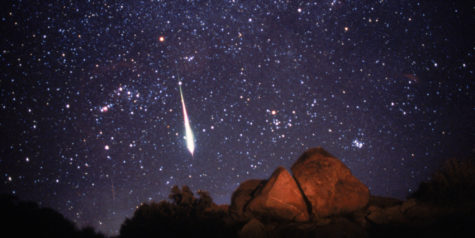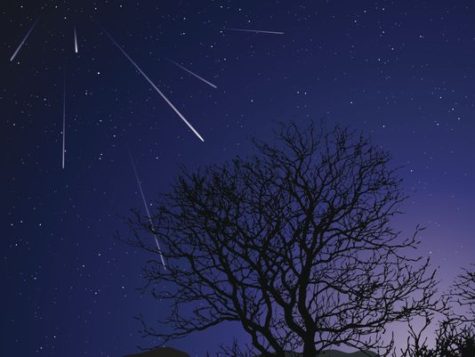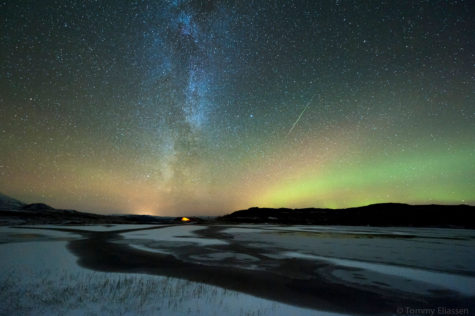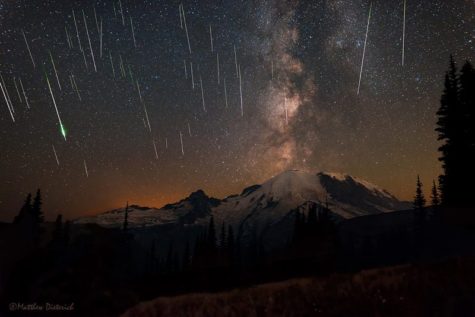Stars
According to Tibetan and Vedic astrology, there are a cluster of stars, called the ‘Rishi’ stars, that ‘appear’ for one week each year – usually during the 8th lunar month (September). According to Tibetan astrology, the Rishi stars will be ‘out’ this year from Sept. 9-15. In Tibetan this is known as ‘Karma Rishi.’
According to Hindu legend, these stars were once great sages of the past, who, upon their death, ascended up into the heavens and became these stars. When they are visible in the night sky, their light is said to possess special healing powers that transform all water into a healing nectar.
Some sources state these stars are the Ursa Major, or the ‘big dipper,’ also known as the Sapta Rishi stars, who are associated with the seven great Rishis of Vedic lore. Other sources say this is the Canopus star, which is associated with the Rishi Agastya, and is said to be the ‘cleanser of waters.’
Typically, Tibetan doctors and healers would place buckets of water outside during this time, then use this water for making their medicines. Lama Dawa remembers how His Holiness Matrul Rinpcoche – a great Tibetan physician – would then boil this water down, thus concentrating it, then use this water to make the herbal medicinal pills, and also to consecrate the water with healing mantras.
Another way of benefiting from this healing water is to bathe in pools, ponds or rivers during this time. Or, collect water in buckets and use that for bathing. Any water – whether it is ocean, river, stream, or water in pools, is imbued with the healing qualities of the stars.
This water can be used to make healing tinctures, or for giving to pets and plants. Even the water in our own bodies can be ‘blessed’ and purified by this special healing energy by exposing your body to the night sky when the stars are out.
It is a particularly auspicious time to do practices such as the Vajra Armor mantra, which is used to consecrate water, or Medicine Buddha mantras and offering pujas.
Prayer:
Rangrig Dorje Rinpoche offers this prayer and mantra to be said while taking a bath outside under these stars:
༈ཇི་ལྟར་བལྟམས་པ་ཙམ་གྱིས་ནི། ལྷ་རྣམས་ཀྱིས་ནི་ཁྲུས་གསོལ་ལྟར།
JI-TAR TAM-PA TSAM-GYI NI / LHA-NAM KYI-NI TRU-SOL TAR /
ལྷ་ཡི་ཆུ་ནི་དག་པ་ཡིས། དེ་བཞིན་བདག་གིས་ཁྲུས་བགྱིའོ།
LHA-YI CHU-NI DAG-PA YI / DE-ZHIN DAG-GI TRU-GYI O /
- Mantra:
ཨོཾ་སརྦ་ཏ་ཐཱ་ག་ཏ་ཨ་བྷི་ཥེ་ཀ་ཏ་ས་མ་ཡ་ཤྲཱི་ཡེ་ཧཱུྃ༔
OM SARWA TAT’HAGATA ABHISHEKA TA SAMAYA SHRI YE HUNG
- Aspiration:
འདི་ནི་ཁྲུས་མཆོག་དཔལ་དང་ལྡན། ཐུགས་རྗེའི་ཆུ་ནི་བླ་ན་མེད།
DI-NI TRU-CHOG PAL-DANG DEN / T’HUG-JE’I CHU-NI LA-NA MED /
བྱིན་རླབས་ཡེ་ཤེས་ཆུ་ཡིས་ནི། ཅི་འདོད་དངོས་གྲུབ་སྩོལ་བར་མཛོད།
JIN-LAB YE-SHE CHU-YI NI / CHI-DOD NGO-DRUB TSAL-WAR DZOD
Western Astrology:
Western astrologer, Terry Nazon, offered this information about the Sapta Rishi Stars:
“They are the fixed stars of Ursa Major the Big Dipper. They are always visible…but during that time in September as the constellation late Leo and early Virgo is right above us in the night sky…they are closest then and right above us.
Because the earth is moving and just like the moon moves across the night sky so will the big dipper…it can also be that the Sun is activating them…for planets and stars to be effective they have to be triggered by a planet or star like the sun.
If you are “charging” water you will want to place the water where it receives the most exposure. For instance maybe there’s tree blocking the Big Dipper in your front yard…and remember, we are made up of 60 % water and in ancient Kabbalah, the text said to bath ourselves in this planetary “rain” they called it.”
The Rishi stars:
- 1. Dubhe The Bear:
Astrology, arrogance, psychic power, destruction; aka Krathu, one of the 7 Rishis (Hindu sages) in Ursa Major; Bast Isis, the Egyptian goddess; “The Eye”; “Heaven’s Pivot”
- 2. Merak:
Prudent, restrained, mistrustful, self-controlled (but angry when roused), love of command, power to achieve, good with animals; Pulaha, one of the 7 Rishis (Hindu sages) of Ursa Major
- 3. Phecda:
Civilising influence, tamer of beasts, transmission of divine knowledge; Pulasthya, one of the 7 Rishis (Hindu sages) of the Great Bear, Ursa Major; bloodbaths, assassinations, riots, sexual perversion
- 4. Tania Borealis:
In the right hind paw of Ursa Major, along with Tania Australis, this star was part of an early Arabian constellation, The Gazelle, of which this group is the “Second Leap”. The Great Bear is mainly martial in action, considered unfortunate for nations and kings.
- 5. Megrez:
Spiritual sight; creativity; violence; Atri, one of the 7 Rishis (Hindu sages), the ruling star of the Great Bear, Ursa Major
- 6. Alioth, The Black Horse:
Suicide among women; danger in pregnancy; Angirasa, one of the 7 Rishis (Hindu sages) in Ursa Major
- 7. Mizar:
Connected with fires of a catastrophic extent and mass calamities; Vasishta, one of the 7 Rishis (Hindu sages) of Ursa Major
- 8. Alula Borealis:
Hindmost foot of Ursa Major. As the northern Alula, it is more fortunate. Associated with female infidelity & revenge. The Great Bear gives a quiet, prudent, suspicious, mistrustful, self-controlled, patient nature, but an uneasy spirit; great anger when roused.
The Canopus Star:
The Canopus star is the second brightest star after Sirius. In Indian Vedic literature, the star Canopus, known as the ‘smiling star’ is associated with the sage Agastya, one of the ancient rishis (the others are associated with the stars of the Big Dipper). Agastya, the star, is said to be the ‘cleanser of waters’ and its rising coincides with the calming of the waters of the Indian Ocean.
Canopus is a bright star most easily visible in the Southern Hemisphere. It is in the constellation Carina, the keel. The star is of a fairly rare type, considered a class F giant on the main sequence of stars. This means it has a mass close to that of the sun.
Because the star’s spectral class is not well studied, it is difficult to establish how far away Canopus is. Parallax measurements with the Hipparcos satellite have established it to be about 313 light-years away.
Canopus can’t be seen from most locations in Europe and North America. Observers in northern latitudes south of 37°N can find the star below Sirius in the southern sky on winter evenings. Canopus is at its highest in February around 9 pm. It is located about 36 degrees to the south of Sirius.
In science fiction, Canopus is perhaps best known for being the parent star for Arrakis, a dusty desert planet in the “Dune” universe.
Canopus is used in space navigation to adjust the position of spacecraft in space. Many spacecraft are equipped with a special camera called the Canopus Star Tracker.
Sources:
The phrase “Dog Days” refers to the hottest days of summer. The Old Farmer’s Almanac lists the traditional timing of the Dog Days: the 40 days beginning July 3 and ending August 11, coinciding with the heliacal (at sunrise) rising of the Dog Star, Sirius.
The rising of Sirius does not actually affect the weather (some of our hottest and most humid days occur after August 11), but for the ancient Egyptians, Sirius appeared just before the season of the Nile’s flooding so they used the star as a “watchdog” for that event. Since its rising also coincided with a time of extreme heat, the connection with hot, sultry weather was made for all time.
More about the Dog Days can be found here: Dog Days of Summer
Source: Almanac.com

What is a meteor shower?
A meteor shower is a spike in the number of meteors or “shooting stars” that streak through the night sky.
Most meteor showers are spawned by comets. As a comet orbits the Sun it sheds an icy, dusty debris stream along its orbit. If Earth travels through this stream, we will see a meteor shower. Although the meteors can appear anywhere in the sky, if you trace their paths, the meteors in each shower appear to “rain” into the sky from the same region.
Meteor showers are named for the constellation that coincides with this region in the sky, a spot known as the radiant. For instance, the radiant for the Leonid meteor shower is in the constellation Leo. The Perseid meteor shower is so named because meteors appear to fall from a point in the constellation Perseus.
Visit our Almanac Page to find out which meteor showers may be visible each month and when they will be at their best, or follow this tag Meteor Shower, to see posts on all the meteor showers visible from earth.
What are shooting stars?
“Shooting stars” and “falling stars” are both names that describe meteors — streaks of light across the night sky caused by small bits of interplanetary rock and debris called meteoroids vaporizing high in Earth’s upper atmosphere. Traveling at tens of thousands of miles an hour, meteoroids quickly ignite from the searing friction with the atmosphere, 30 to 80 miles above the ground. Almost all are destroyed in this process; the rare few that survive and hit the ground are known as meteorites.
When a meteor appears, it seems to “shoot” quickly across the sky, and its small size and intense brightness might make you think it is a star. If you’re lucky enough to spot a meteorite (a meteor that makes it all the way to the ground), and see where it hits, it’s easy to think you just saw a star “fall.”

How can I best view a meteor shower?
Get away from the glow of city lights and toward the constellation from which the meteors will appear to radiate.
For example, drive north to view the Leonids. Driving south may lead you to darker skies, but the glow will dominate the northern horizon, where Leo rises. Perseid meteors will appear to “rain” into the atmosphere from the constellation Perseus, which rises in the northeast around 11 p.m. in mid-August.
After you’ve escaped the city glow, find a dark, secluded spot where oncoming car headlights will not periodically ruin your sensitive night vision. Look for state or city parks or other safe, dark sites.
Once you have settled at your observing spot, lie back or position yourself so the horizon appears at the edge of your peripheral vision, with the stars and sky filling your field of view. Meteors will instantly grab your attention as they streak by.
How do I know the sky is dark enough to see meteors?
If you can see each star of the Little Dipper, your eyes have “dark adapted,” and your chosen site is probably dark enough. Under these conditions, you will see plenty of meteors.
What should I pack for meteor watching?
Treat meteor watching like you would the 4th of July fireworks. Pack comfortable chairs, bug spray, food and drinks, blankets, plus a red-filtered flashlight for reading maps and charts without ruining your night vision. Binoculars are not necessary. Your eyes will do just fine.
Info from: Stardate and Universe Today
The Geminids is the king of the meteor showers. It is considered by many to be the best shower in the heavens, producing up to 120 multicolored meteors per hour at its peak. It is produced by debris left behind by an asteroid known as 3200 Phaethon, which was discovered in 1982.
The shower runs annually from December 7-17. It peaks this year on the night of the 13th and morning of the 14th. Best viewing will be from a dark location after midnight. Meteors will radiate from the constellation Gemini, but can appear anywhere in the sky.
The Leonids is an average shower, producing up to 15 meteors per hour at its peak. This shower is unique in that it has a cyclonic peak about every 33 years where hundreds of meteors per hour can be seen. That last of these occurred in 2001. The Leonids is produced by dust grains left behind by comet Tempel-Tuttle, which was discovered in 1865. The shower runs annually from November 6-30. Best viewing will be from a dark location after midnight. Meteors will radiate from the constellation Leo, but can appear anywhere in the sky.
Source: SeaSky
The Taurids is a long-running minor meteor shower producing only about 5-10 meteors per hour. It is unusual in that it consists of two separate streams. The first is produced by dust grains left behind by Asteroid 2004 TG10. The second stream is produced by debris left behind by Comet 2P Encke. The shower runs annually from September 7 to December 10. Best viewing will be just after midnight from a dark location far away from city lights. Meteors will radiate from the constellation Taurus, but can appear anywhere in the sky.
Source: SeaSky
The Draconids is a minor meteor shower producing only about 10 meteors per hour. It is produced by dust grains left behind by comet 21P Giacobini-Zinner, which was first discovered in 1900. The Draconids is an unusual shower in that the best viewing is in the early evening instead of early morning like most other showers. The shower runs annually from October 6-10. Best viewing will be in the early evening from a dark location far away from city lights. Meteors will radiate from the constellation Draco, but can appear anywhere in the sky.
Source: SeaSky
The Orionids is an average meteor shower producing up to 20 meteors per hour at its peak. It is produced by dust grains left behind by comet Halley, which has been known and observed since ancient times. The shower runs annually from October 2 to November 7. Best viewing will be from a dark location after midnight. Meteors will radiate from the constellation Orion, but can appear anywhere in the sky.
Source: SeaSky
Get set for the meteoritic grand finale of summer. The middle week of August is the peak of the Perseid meteor shower.
The Perseids is one of the best meteor showers to observe, producing up to 60 meteors per hour at its peak. It is produced by comet Swift-Tuttle, which was discovered in 1862. The Perseids are famous for producing a large number of bright meteors. The shower runs annually from July 17 to August 24. Best viewing will be from a dark location after midnight. Meteors will radiate from the constellation Perseus, but can appear anywhere in the sky.
It peaks this year (2017) on the night of August 12 and the morning of August 13. The waning gibbous moon will block out many of the fainter meteors this year, but the Perseids are so bright and numerous that it should still be a good show.
Of course, like with any meteor shower, it’s worth starting to watch a few days prior to the peak date. Although meteor streams like the Perseids have been modeled and mapped over the years, there are still lots of surprises out there. Plus, starting an early vigil is insurance that you at least catch some action in the event that you’re clouded out on game day! The Perseids are already active, spanning a season from July 17th to August 24th.
Here’s a sky map:
Source: SeaSky and other sources
The Delta Aquarids is an average meteor shower that can produce up to 20 meteors per hour at its peak. It is produced by debris left behind by comets Marsden and Kracht. The shower runs annually from July 12 to August 23. Best viewing will be from a dark location after midnight. Meteors will radiate from the constellation Aquarius, but can appear anywhere in the sky.
Source: SeaSky


















